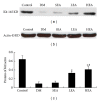Electroacupuncture regulates apoptosis/proliferation of intramuscular interstitial cells of cajal and restores colonic motility in diabetic constipation rats
- PMID: 24348706
- PMCID: PMC3852313
- DOI: 10.1155/2013/584179
Electroacupuncture regulates apoptosis/proliferation of intramuscular interstitial cells of cajal and restores colonic motility in diabetic constipation rats
Abstract
Injury of interstitial cells of Cajal (ICC) is associated with gut dysmotility in diabetic rats. We have shown an acceleration of the colonic contractility by electroacupuncture stimulation (EAS). However, little is known about potential roles of EAS on colonic transit and ICC. In this study, we evaluate the effect of EAS on colonic transit and investigate whether apoptosis/proliferation of ICC was involved in regulative effect of EAS on colonic transit. Rats were randomly assigned to normal, diabetic, diabetic-plus-sham stimulation, diabetic-plus-low-frequency stimulation, and diabetic-plus-high-frequency stimulation groups. Bead expulsion test was used for measuring the distal colonic transit. The Kit (ICC marker) was detected by western blot. Apoptotic ICC was detected by terminal dUTP nucleotide end labeling. Proliferating ICC was identified by Kit/Ki67 double immunofluorescent staining on whole mount preparations. Ultrastructure changes of ICC were studied using electron microscopy. Results showed that high-frequency stimulation significantly promoted colonic transit. Low- and high-frequency stimulation markedly rescued intramuscular ICC from apoptosis. Abundant proliferating intramuscular ICC was found in low- and high-frequency stimulation groups. Our results indicate that high-frequency EAS has stimulatory effect on the distal colonic transit, which may be mediated by downregulation of the apoptosis and upregulation of the proliferation of intramuscular ICC.
Figures






Similar articles
-
miR-222 regulates cell growth, apoptosis, and autophagy of interstitial cells of Cajal isolated from slow transit constipation rats by targeting c-kit.Indian J Gastroenterol. 2021 Apr;40(2):198-208. doi: 10.1007/s12664-020-01143-7. Epub 2021 Apr 1. Indian J Gastroenterol. 2021. PMID: 33792838
-
Electroacupuncture at ST36 ameliorates gastric emptying and rescues networks of interstitial cells of Cajal in the stomach of diabetic rats.PLoS One. 2013 Dec 31;8(12):e83904. doi: 10.1371/journal.pone.0083904. eCollection 2013. PLoS One. 2013. PMID: 24391842 Free PMC article.
-
[Effects of Electroacupuncture on Ultrastructure of Interstitial Cells of Cajal and Stem Cell Factor-kit Signal Pathway of Gastric Antrum in Diabetic Gastroparesis Rats].Zhen Ci Yan Jiu. 2017 Dec 25;42(6):482-8. doi: 10.13702/j.1000-0607.2017.06.003. Zhen Ci Yan Jiu. 2017. PMID: 29318852 Chinese.
-
[Effect of electroacupuncture at "Tianshu"(ST 25) on colonic smooth muscle structure and interstitial cells of cajal in slow transit constipation rats].Zhen Ci Yan Jiu. 2011 Jun;36(3):171-5. Zhen Ci Yan Jiu. 2011. PMID: 21793380 Chinese.
-
The interstitial cells of Cajal and a gastroenteric pacemaker system.Arch Histol Cytol. 2002 Mar;65(1):1-26. doi: 10.1679/aohc.65.1. Arch Histol Cytol. 2002. PMID: 12002607 Review.
Cited by
-
Prevention of colon enlargement by TNF-α antagonist in a streptozotocin-induced diabetic rat model.Histol Histopathol. 2024 Nov;39(11):1443-1455. doi: 10.14670/HH-18-735. Epub 2024 Mar 18. Histol Histopathol. 2024. PMID: 38572731
-
Laxative effect of Wenyang Yiqi Decoction on loperamide-induced astriction model mice.Ann Transl Med. 2023 Feb 28;11(4):170. doi: 10.21037/atm-23-6. Ann Transl Med. 2023. PMID: 36923099 Free PMC article.
-
Laxative Effects of Yangyin Tongmi Capsule on a Model of Diphenoxylate-Induced Constipation in Mice.Evid Based Complement Alternat Med. 2020 Feb 21;2020:1471824. doi: 10.1155/2020/1471824. eCollection 2020. Evid Based Complement Alternat Med. 2020. PMID: 32148532 Free PMC article.
-
Electroacupuncture reduces blood glucose by regulating intestinal flora in type 2 diabetic mice.J Diabetes. 2022 Oct;14(10):695-710. doi: 10.1111/1753-0407.13323. Epub 2022 Oct 4. J Diabetes. 2022. PMID: 36195536 Free PMC article.
-
Electroacupuncture Alleviates Functional Constipation in Mice by Activating Enteric Glial Cell Autophagy via PI3K/AKT/mTOR Signaling.Chin J Integr Med. 2023 May;29(5):459-469. doi: 10.1007/s11655-023-3594-3. Epub 2023 Mar 28. Chin J Integr Med. 2023. PMID: 36973529
References
-
- Luo D, Liu S, Xie X, Hou X. Electroacupuncture at acupoint ST-36 promotes contractility of distal colon via a cholinergic pathway in conscious rats. Digestive Diseases and Sciences. 2008;53(3):689–693. - PubMed
-
- Iwa M, Matsushima M, Nakade Y, Pappas TN, Fujimiya M, Takahashi T. Electroacupuncture at ST-36 accelerates colonic motility and transit in freely moving conscious rats. American Journal of Physiology. 2006;290(2):G285–G292. - PubMed
-
- Rangwala F, Zafar SY, Abernethy AP. Gastrointestinal symptoms in cancer patients with advanced disease: new methodologies, insights, and a proposed approach. Current Opinion in Supportive and Palliative Care. 2012;6(1):69–76. - PubMed
LinkOut - more resources
Full Text Sources
Other Literature Sources

